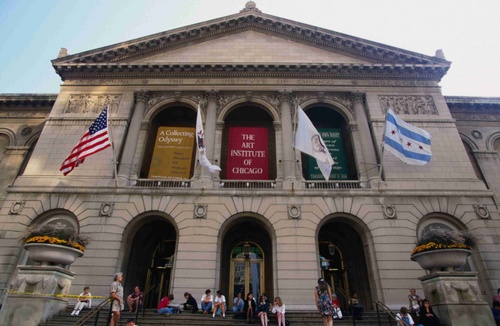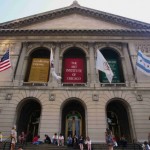By DANIEL GRANT
Museums were much in the news in 2007, not necessarily for the happiest of reasons. Would-be donors of valuable artworks complained that limitations on what are called “fractional” gifts (time-sequenced donations with no defined end date and the opportunity for escalating annual deductible valuations) enacted in the 2006 Pension Protection Act took away their incentive to donate these pieces to museums. Donations of these types of gifts declined sharply. Legislation to restore most of the donor benefits (“Promotion of Artistic Giving Act of 2007”) was introduced into Congress last fall by Representatives Tom Udall (D-NM) and Phil English (R-Pa). That bill joins Senator Patrick Leahy’s (D-VT) long-running “The Artist-Museum Partnership Act,” which would permit artists (as well as composers and writers) to deduct the full fair market value of their work when it is donated to museums and libraries, rather than just the cost of the physical materials they used, a measure that museum directors claim would vastly expand their contemporary art holdings without using up their acquisition funds.
Meanwhile, in the past year, a number of museums – most notably the Princeton University Art Museum, the J. Paul Getty Museum and Yale University Art Gallery– found themselves in the position of giving up objects from their collections, whose provenance was in dispute, to the Italian and Greek governments. (The St. Louis Art Museum, for its part, has been locked in a standoff with the Egyptian government over a 19th Dynasty mummy mask.) Former Getty curator Marion True, however, caught a break in November when a Greek appeals court threw out the government’s case against her for conspiracy to acquire a looted ancient gold wreath, which the Getty purchased in 1993 for $1.15 million, in deference to California’s three-year statute of limitations. (The wreath was returned in August.) She has been on trial in Italy on similar charges since 2005.
Acquiring new art, planning a renovation or addition and just keeping the place afloat is expensive for museums. Looking for new revenues in the manner of the Museum of Fine Arts, Boston, the Cleveland Museum of Art, the Louvre and some others, the Art Institute of Chicago leased 92 of its most prized Impressionist and Post-Impressionist paintings to the Kimbell Art Museum in Fort Worth, Texas for a reported $1 million. The Albright-Knox Art Gallery in Buffalo, New York weathered considerable condemnation for its decision to sell at auction more than 200 old and ancient objects from its permanent collection in order to raise money ($76.5 million) for the acquisition of contemporary art, and the yet-to-open Crystal Bridges in Bentonville, Arkansas, led by Alice Walton, widow of Wal-Mart founder Sam Walton, already has been savaged for its aggressive open-checkbook style of acquiring art from institutions that need the money. The most noteworthy of those institutions has been Fisk University in Nashville, Tennessee, whose desire for operating money led officials to agree to a $30 million art-sharing plan involving a Georgia O’Keeffe painting and a number of other works. Fisk University was not the only institution that has used its art collection to find money to pay the bills: Maier Museum of Art of Randolph-Macon University in Lynchburg, Virginia and Rockford College in Illinois both consigned a large number of artworks to auction houses in 2007.
Both the American Association of Museums and the Association of Art Museum Directors have criticized these and other college museums for not using deaccessioning funds for the purchase of new artworks, which is part of their membership guidelines, but most college and university museums are not members anyway. Even if they were members, the larger institutions’ search for money and view of their art holdings as fungible assets to be tapped as needed probably would not change their actions. The two associations have been fighting rearguard actions of late, such as colleges’ use of deaccessioning funds, fractional gifts and the artist deduction issue. They can always find some members of Congress to sponsor bills but not enough members to pass them. Perhaps, the most troubling problem for museums is the inability of their two largest advocacy groups to accomplish anything.
In addition to objects for the collection, museums also seek donations of money to support their growing and evermore costly operations. According to a survey conducted by the Chronicle of Philanthropy of major educational, arts and social service institutions in the U.S. for the year 2006 and released last October, Houston’s Museum of Fine Arts received the largest amount of cash gifts ($185,834,751) of all the country’s arts organizations, followed by New York’s Museum of Modern Arts ($133,523,000), Smithsonian Institution ($131,240,183), Boston’s Museum of Fine Arts ($130,443,296), Metropolitan Museum of Art ($108,922,925) and the Philadelphia Museum of Art ($75,796,564). That same report noted that cultural and other organizations had invested a growing percentage of their endowments in hedge funds – 11 percent for the Museum of Modern Art (jumping from zero percent two years earlier), just over three percent for the Philadelphia Museum of Art, 16 percent at the Currier Museum of Art in New Hampshire and 17 percent at New York’s Jewish Museum.
The Smithsonian Institution found itself in the line of fire as a result of separate but equally damning investigations by Republican Iowa Senator Charles Grassley and the Government Accounting Office, which found that the facilities required $2.3 billion in overall repairs but spent lavishly on the housing, travel and salary of Smithsonian Secretary Lawrence M. Small. Small, whose 2000 $356,000 salary had jumped to $819,000 by 2005 without any apparent reason, resigned in March.
New York’s Museum of Modern Art started the year with a minor scandal, when it was revealed that 52 year-old Director Glenn Lowry received more money -- $5.35 million, in fact, between 1995 and 2003 – than was reported in MoMA’s tax forms, the result of a trust set up by two of the museum’s wealthiest trustees, David Rockefeller and Agnes Gund in order to keep him at the museum. Addition, it was announced that in 2004, the Modern purchased an apartment for Lowry in its Museum Tower where the highest paid museum director in the country ($1.28 million in 2005) lives rent-free. That unpleasantness was eclipsed in September by the appointment of 58 year-old Kathy Halbreich, who resigned in March as director of Minneapolis’ Walker Art Center after 16 years, to the newly created position of associate director in charge of contemporary art. It also puts a skilled hand near the helm if Lowry bows out gracefully, as some speculation had it.
Speaking of retiring, Metropolitan Museum of Art Director Philippe de Montebello turned 70 last May and celebrated 30 years in the top spot, sparking speculation as to how much longer he will remain. De Montebello has denied making any plans to retire, although that hasn’t dampened whispers of who might replace him, with such names as Neil MacGregor, the 61 year-old director of the British Museum, the 43 year-old Michael Govan, director of the Los Angeles County Museum of Art and even Glenn Lowry being mentioned.
- The Art Institute of Chicago
- The Cleveland Museum of Art
- The Boston Museum of Fine Arts
CultureGrrl - Promotion of Artistic Giving Act of 2007
Gather.com - The Artist-Museum Partnership Act
American Association of Museums
Association of Art Museum Directors
Chronicle of Philanthropy
All images found via Google.







